
From its modern interpretations to its antecedents when maritime nations would send young naval officer candidates to sea, sail training provides an unconventional and effective way of building many useful skills on and off the water.

Pacific World is a Sun-class cruise ship built in 1995 and operated by Peace Boat. At the time of her construction, she was one of the largest cruise ships in the world. She was the lead ship of her class that included sister ships MS Charming and the P&O ships Pacific Explorer and Queen of the Oceans.
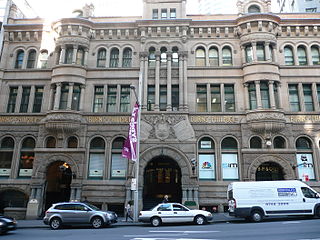
Burns Philp was once a major Australian shipping line and merchant that operated in the South Pacific. When the well-populated islands around New Guinea were targeted for blackbirding in the 1880s, a new rush for labour from these islands began. James Burns and Robert Philp purchased several well-known blackbirding ships to quickly exploit the human resource in this region, and Burns Philp entered the slave trade. The company ended its involvement in blackbirding in 1886. In later years the company was a major player in the food manufacturing business. Since its delisting from the Australian Securities Exchange in December 2006 and the subsequent sale of its assets, the company has mainly become a cashed up shell company. It is wholly owned by Graeme Hart's Rank Group.

TSS Fairstar was a popular Australian-based cruise ship operating out of Sydney for 22 years. Originally completed in 1957 as the British troopship Oxfordshire, it was converted to become the Fairstar in 1964 for immigrant voyages and from December 1974 was permanently engaged in cruising.
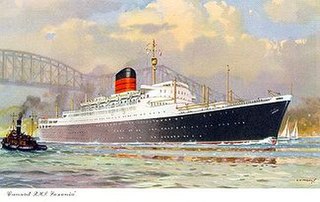
RMS Saxonia was a British passenger liner built by John Brown & Company at Clydebank, Scotland for the Cunard Steamship Company for their Liverpool-Montreal service. She was the first of four almost identical sister ships built by Browns between 1954 and 1957 for UK-Montreal service. The first two of these ships, Saxonia and Ivernia were extensively rebuilt in 1962/3 as dual purpose liner/cruise ships. They were renamed Carmania and Franconia respectively and painted in the same green cruising livery as the Caronia. Carmania continued transatlantic crossings and cruises until September 1967 when she closed out Cunard's Montreal service. She and her sister had been painted white at the end of 1966 and from 1968 Carmania sailed as a full time cruise ship until withdrawal after arriving at Southampton on 31 October 1971. In August 1973 she was bought by the Soviet Union-based Black Sea Shipping Company and renamed SS Leonid Sobinov. The ship was scrapped in 1999.
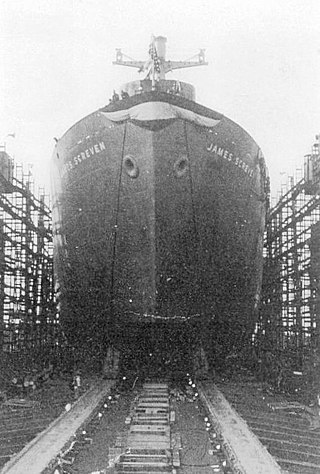
USS Shaula (AK-118) was a Crater-class cargo ship, converted from a Liberty Ship, commissioned by the US Navy for service in World War II. She was first named after James Screven, an American general during the American Revolutionary War. She was renamed and commissioned after Shaula, the second-brightest star system in the constellation of Scorpius. She was responsible for delivering troops, goods and equipment to locations in the war zone.

RMS Sylvania was an ocean liner built in 1957 by John Brown & Co (Clydebank), in Glasgow, for the United Kingdom-based shipping company Cunard Line. She was the last Cunard Line vessel built specifically for transatlantic crossings. The ship was later heavily rebuilt as a cruise ship, and sailed under the names SS Fairwind, SS Sitmar Fairwind, SS Dawn Princess and SS Albatros before being scrapped in 2004. She was renamed SS Genoa for her last voyage.

Tradewind is a Dutch topsail schooner. She was built in the Netherlands in 1911 as a herring lugger named Sophie Theresia.

The Belorussiya-class was a class of cruiseferries that were built by Wärtsilä Turku Shipyard, Finland in 1975–1976 for the Black Sea Shipping Company, Soviet Union. The five ships in the class were originally used in cruiseferry service around the Black Sea. During the 1980s all ships in the class were rebuilt into cruise ships. During the end of the 1990s all ships in the class were sold to other operators. The remaining ships in this class ended service in 2020. All ships as of 2022 have been scrapped except for the Enchanted Capri, which was shipwrecked on the Gulf coast of Mexico and only has partially been dismantled.
The Alphabet Fleet was a fleet of vessels owned and operated by the Reid Newfoundland Company as part of the provisioning of the 1898 Railway contract between the Dominion of Newfoundland and the Reid Newfoundland Company. The vessels were named after places in Scotland, the native homeland of Sir Robert Gillespie Reid, founder of the Reid Newfoundland Company.

Falie is a 33.4-metre (110 ft) ketch that traded for many years in Australian waters. Originally built in 1919/1920 as a speculation by her builder, rigged as a schooner and named Hollands Trouw after the shipyard where she was built, she was purchased by the Spencer's Gulf Transport Company, renamed, and used for coastal trading in South Australia. The vessel was commissioned into the Royal Australian Navy (RAN) as HMAS Falie during World War II, serving first as an examination vessel primarily patrolling the Port of Sydney, Australia, then as an armed stores ship.
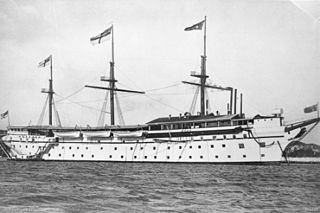
HMAS Tingira was a training ship operated by the Royal Australian Navy (RAN) between 1911 and 1927. Alexander Hall & Co. built the ship in Scotland in 1866 as the passenger clipper Sobraon; she was the largest composite-hull sailing vessel ever built. She sailed on an annual migration run between England and Australia until 1891, when she was sold to the colonial government of New South Wales for use as a reformatory ship. The vessel was then sold to the federal government in 1911, and entered RAN service. Tingira was paid off in 1927, but despite efforts to preserve the ship, was broken up in 1941.

SS Ferret was an iron screw steamship of 460 tons built in Glasgow (Scotland) in 1871 by J & G Thomson, Glasgow.

Lavia was a cruise ship that caught fire and sank in Hong Kong Harbour in 1989. She was built for Cunard White Star Line in 1947 as the cargo liner Media. In 1961 she was sold to Italy, rebuilt as an ocean liner and renamed Flavia. In 1969, she was refitted as a cruise ship and renamed Flavian. In 1982 she was sold to Panama and renamed Lavia. She was undergoing a refit when the fire occurred. The damage to her was so great that she was scrapped.

HMS Sealark was a Royal Navy vessel used primarily for hydrographic survey work. She was originally a luxurious private auxiliary steam yacht for a number of wealthy owners and in 1903 was acquired by the Royal Navy, serving until 1914. She was sold to James Patrick Steamships Ltd and converted to a merchant ship for the Australian coast and finally hulked in 1924.

Sitmar Cruises and its predecessor Sitmar Line were company names derived from the acronym for the Società Italiana Trasporti Marittimi. SITMAR originally was an Italian shipping line founded by Russian émigré Alexandre Vlasov, however the company's headquarters were later transferred to Monaco. Vlasov initially operated cargo services from 1937, gradually replacing these with passenger services from 1947 until 1988, when SITMAR was sold to the Peninsular and Oriental Steam Navigation Company (P&O). After the sale, most of the former SITMAR ships were transferred to the fleet of P&O subsidiary Princess Cruises, while one, TSS Fairstar, became the sole vessel of the newly created P&O-Sitmar Cruises. As of July 2018, one briefly named former SITMAR ship was still operational, as Cruise & Maritime Voyages's Columbus. However, two other vessels originally ordered by SITMAR but delivered to P&O, sailed under the Princess banner before operating from Australia for a number of years, such as Pacific Jewel and Pacific Dawn. As of 2021, Pacific Dawn, set to become Ambience is the only survivor, with Columbus and Pacific Jewel being sold for scrap.
SS Hertford was a refrigerated cargo steamship that was launched in Germany in 1917, seized by the United Kingdom in 1920 as World War I reparations, and sunk by a U-boat in 1942 with the loss of four members of her crew.
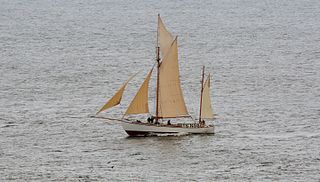
Wyvern is a 60-foot (18 m) open sea sailing ship operated by Stavanger Maritime Museum. The ship was designed by Colin Archer on a commission from British-born Frederick Croft and was launched on 10 August 1897. She sailed under the German flag from 1909. The Norwegian newspaper editor Rolf Thommessen bought her in 1924 and renamed her Havfruen III. This name was kept by the English owners, Anne and Terrence Carr, who acquired her in 1947 and sold her to Christian-Frederick Mattner in 1970--who renamed her to the original 'Wyvern'.She was contracted for sale to a Norwegian consortium for £ 50 000 //of which £30 000 is still owed// after having been hijacked from San Antonio Ibiza.
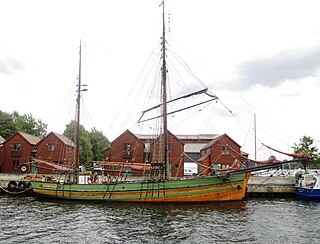
Anna Kristina is a Norwegian-flagged, galeas-rigged Hardangerjakt. Originally named Dyrafjeld, the sloop-rigged vessel was built on a Norwegian farm in 1889. The ship's early career was as a cargo ship in the Hardanger region, with occasional voyages as far afield as Russia. She was sold to new owners and rerigged as a galeas in the late 1920s. The sails were removed during World War II, but continued in merchant service until the mid-1970s. After a series of accidents, the vessel was laid up, then sold to new owners, who restored the vessel and renamed her Anna Kristina. Charter work occurred throughout the 1980s, including involvement in the First Fleet Re-enactment Voyage.
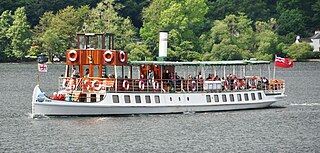
SY Tern, now operating as MY Tern, is a passenger vessel on Windermere, England. Launched in 1891 she was built for the steamer service carrying passengers from the Furness Railway. She underwent several changes in owner as companies were merged throughout the twentieth century, and spent time as a sea cadet training ship during the Second World War. Refitted several times, her original steam engines have been replaced with diesel engines. Tern is the oldest vessel operating on Windermere, and is a member of the National Historic Fleet. She is currently operated by Windermere Lake Cruises as the flagship of their fleet.


















